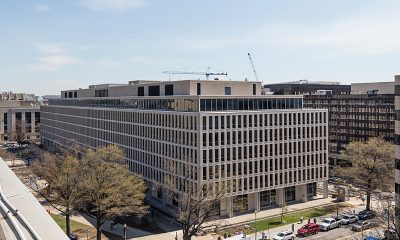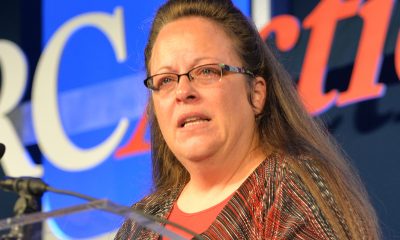Opinions
An unlikely revolution is happening at Christian universities
More than half have enacted LGBTQ non-discrimination policies

Recent headlines have been filled with messages of doom and gloom for LGBTQ people. From bans on transgender women competing in sports to “don’t say gay” laws, it seems evident that conservative Republicans are freshly committed to rolling back the rights of LGBTQ people across the United States.
Yet, despite such recent setbacks, a student-led movement for LGBTQ inclusion is gaining ground in what would seem to be one of the unlikeliest settings — Christian colleges and universities.
Over the past few years, I’ve collected extensive data on U.S. Christian colleges and universities’ policies toward LGBTQ students. In one study, I found that 55% of all Christian colleges and universities in the United States have nondiscrimination policies inclusive of sexual orientation. In another recent study, I found that nearly half of all Christian colleges and universities are home to officially recognized LGBTQ student groups.
Even some of the most conservative Christian colleges and universities have changed their approach to LGBTQ students. When analyzing data collected in 2013, I found that nearly one-third of all Christian colleges and universities had adopted bans on so-called “homosexual acts” or “homosexual behavior” in their student handbooks. Yet, when reviewing Christian colleges and universities’ handbooks again over the past year, I found that under one-fourth of Christian colleges and universities had such discriminatory bans.
Why are some Christian colleges and universities becoming more accommodating—and even welcoming—to LGBTQ students?
There are several major reasons, but one of the most important is that several Christian denominations already embrace their LGBTQ members. Denominations such as the Episcopal Church, United Church of Christ, Evangelical Lutheran Church in America, Disciples of Christ, and Presbyterian Church USA, for example, allow ministers to officiate same-sex weddings. An increasing number of nondenominational churches also affirm LGBTQ people. Those Christian colleges and universities that are already associated with affirming denominations are certainly among the most likely to affirm their LGBTQ students.
Another reason that many Christian colleges and universities are becoming welcoming toward LGBTQ students is that they do not necessarily believe their primary mission is to hold all students to the specific religious tenets of their associated denomination. Rather, they see their primary mission as providing an important service (education) to the broader society. Just as Christian hospitals do not refuse to provide medical treatment to people who are not members of their associated denominations, many Christian colleges and universities have chosen not to deny people an education simply because certain people are not members of their associated denominations.
A rising number of Christian colleges and universities also recognize the harms that occur when people are discriminated against on the basis of sexual orientation or gender identity. A recent survey by Religious Exemption Accountability Project shows that 12% of all Christian college and university students self-identify as LGBTQ. Because studies show that LGBTQ people in non-affirming Christian colleges and universities report greater rates of depression, anxiety, and suicidal ideation, many Christian schools understand they would be harming a significant number of their students if they continued to discriminate against LGBTQ people.
And still other schools are simply concerned with their bottom lines. The United States is projected to go over a “demographic cliff” in 2025, at which time the number of 18-year-olds nationwide will drop dramatically. Some reports say that one-third of all private colleges and universities nationwide will face major financial crises over the next decade, causing them to close or pursue mergers. Many Christian colleges and universities recognize that adopting discriminatory policies toward LGBTQ students would alienate significant portions of their potential student body.
Certainly, despite these encouraging trends, those who are committed to LGBTQ rights should not be complacent. Many schools have still been slow to extend nondiscrimination protections and housing accommodations to trans students. And the Religious Exemption Accountability Project estimates that as many as 100,000 LGBTQ students are currently enrolled at Christian colleges and universities that still refuse to affirm the dignity and rights of LGBTQ people. That organization recently filed a class-action lawsuit against the U.S. Department of Education, challenging the federal government’s policy of providing loans even to Christian colleges and universities that otherwise violate Title IX protections for LGBTQ students.
It is likely the case that some Christian colleges and universities will not change their policies toward LGBTQ rights unless they are legally required to do so. Still, at Christian colleges and universities across the United States, LGBTQ students are not waiting around. LGBTQ students are actively mobilizing to bring about inclusive policies at their schools, and at a surprising number of schools, they are succeeding.
Jonathan S. Coley is Assistant Professor of Sociology at Oklahoma State University and a Public Fellow at the Public Religion Research Institute.

Voters handed Democrats a sweeping victory across the country in the Nov. 4 elections. Donald Trump’s Republicans paid dearly for their inability to restrain or conceal their recklessness and cruelty.
In response to being roundly repudiated at the polls, Trump boasted, lied, made insults and threats. Mind you, this is a man who confuses dementia screening with an IQ test. And he once proposed nuking hurricanes.
Trump’s howlers, including the claim that every election he loses is rigged, are persuading fewer and fewer people.
You would never know, on this bright autumn morning, that a pitched battle is underway for the soul of America. As I sip my coffee in the McDonald’s, a little girl walking by with her daddy climbs into the chair at the next table. She is holding a TV remote control for some reason. I ask her not to point it at me because I don’t want to be switched off.
To be honest, there are people I wouldn’t mind switching off, at least from my newsfeed. For example, I saw this headline concerning an obnoxious congresswoman: “Nancy Mace escalates fallout from foul-mouthed airport meltdown with legal threats after criticism from fellow Republicans.”
Is it possible that Rep. Mace, who is running for governor of South Carolina and has been calling trans people crazy, is so starved of attention that she has to scream at officers in airports and threaten lawsuits? I stress that I’m just a humble commentator and do not mean to provoke her.
I can’t help recalling that the phrase “Trump Derangement Syndrome” arose not as a reference to Trump’s own mental health issues but as an effort to deflect such concerns onto his critics. Lately, however, we who wish to be rid of the Worst President Ever have gone from being mad to being domestic terrorists in the eyes of Trump diehards. We are also called insurrectionists, despite never having incited a riot at the U.S. Capitol, because the leading insurrectionist—who deems himself above the law—is considering invoking the Insurrection Act to consolidate dictatorial power.
Are you keeping up with all this? I know it sounds crazy. You never know what jarring images you’ll stumble upon. On election night I switched to CNN, saw former Chicago mayor Rahm Emanuel, and immediately reached for my remote control like that little girl in the McDonald’s. And Rahm is a Democrat!
New York City Mayor-elect Zohran Mamdani is an immigrant who grew up in New York. I am a native Washingtonian who grew up in Maryland’s 8th congressional district, currently represented by constitutional scholar Jamie Raskin. Raskin has happily dubbed Mamdani an FDR Democrat.
You might think comparing a gifted young politician to Franklin Delano Roosevelt would not scandalize anyone at this point; but you would be wrong. Lots of Republicans still decry FDR as a socialist. These are the same people set on robbing millions of their healthcare and nutritional assistance.
Trump, who hosted a Great Gatsby-themed party at Mar-a-Lago hours before millions of Americans lost their SNAP benefits, touted the Roaring Twenties as a high point in America’s past. I don’t want to burst his bubble, so please don’t tell him that the 1920s ended in a stock market crash that ushered in the Great Depression. God forbid his tariffs lead to another crash. He would likely blame it on Mamdani, rebrand it a communist Islamic jihad, and deport it to Eswatini.
Democrats like me support capitalism, but with guardrails. By contrast, the oligarchs—epitomized by Elon Musk with his recently approved $1 trillion pay package—love to blame others for the harm they cause, while making off with the moolah. Do not fall for it.
I am rooting for Mamdani, who wants working people to be able to afford to live in New York. He includes trans people in his vision. His victory speech was a far cry from the Islamophobic caricature painted by his detractors, who range from right-wing pundits to Andrew Cuomo.
Based on the smears, you might expect the mayor-elect to rush to Washington to demolish part of the White House, had the president not beaten him to it. Yet in the wake of Mamdani’s historic victory, billionaires who fought tooth and nail to defeat him bent the knee and pledged their help.
Mamdani is not the model for all Democrats; he reflects but one part of our diverse coalition. The midterm elections are a year away. All our voices and votes will be needed to defeat the authoritarians.
Copyright © 2025 by Richard J. Rosendall. All rights reserved.
Richard Rosendall is a writer and activist who can be reached at [email protected].

Blade contributor Peter Rosenstein is crossing the Atlantic on the Celebrity ASCENT. He filed these dispatches from his journey.
Blog # 1- 2025 Celebrity ASCENT transatlantic cruise
Spent two great days in Rome. I don’t sleep on planes so the first morning was kind of a blur. I had arranged for a taxi from the airport, which worked well, and arrived at my hotel, the Nuova Nord, near the train station, about 10:00am. Check in time is officially 4:00pm but I lucked out, and got into my room by 10:30. This just added to my feeling good about the hotel, along with the $115 a night cost, including breakfast. So put my suitcase in the room and headed out to walk around Rome. My first stop as usual in Rome was the Trevi Fountain, which I love. Once there, did what I always do to get a great picture. Headed across the street from the fountain to the second floor of Benetton. They still have one window that remains clear, and you get the best picture above the crowds. Then I kept walking past the Coliseum, and eventually over toward the Vatican. I had made plans in advance to have dinner with Samantha Basar the new staff addition to My Lux Cruise travel agents, and Jill Lotenberg. Jill is an amazing professional photographer, and documents the cruises we go on. We had a nice early relaxed dinner, and after walking it off, I was back at my hotel before 8:00pm for a good night’s sleep.
The next morning met a D.C. friend, John, who just happened to be in Rome visiting his parents. John’s mom is Italian, and I was surprised to find he speaks the language fluently. We went for coffee at 11:00am at a café he likes near the Pantheon. He swore by their coffee and pastry, and he was right, it was really good. Then we spent a few hours walking the city, and ended up at the Basilica di Santa Maria Maggiore to see the tomb of Pope Francis. There was a long line but it moved really fast, and the tomb is like the former Pope, very simple, but truly impressive. After that John found a scooter to ride back to meet his parents. I think it took a lot of guts to ride a scooter into Rome traffic. I spent a little more time walking around. It was going to be an early night with some pizza for dinner.
The next morning, I headed over to the UNA hotel, just a couple of blocks away, to meet the bus arranged to take my group to Civitavecchia, the port about an hour out of Rome, where we boarded the Celebrity ASCENT, our home for the next thirteen days. That all went really smoothly, and I was onboard, in my stateroom, before 11:00 AM. Then it was meeting my butler, yes, I have one, as does everyone in the Retreat, and also met my very charming room attendant, who had made sure my bedding was all hypoallergenic. Then walked around the ship to see if there were any changes since my cruise last year. There didn’t seem to be any. Then at 4:30 headed to the sail-away party Dustin and Scott, my favorite travel agents, had prepared for our group in their suite, the Iconic Suite, to meet old and new friends. We left port a little late as there apparently was a medical emergency even before we left port, and an ambulance was called to take someone off the ship. Turned out it was a member of our group, but thankfully he is ok. When we finally set sail, we all headed to the first of the nightly, listed in the daily newsletter, as the LGBTQIA+ get togethers, in the Eden lounge. There were more people there than we expected, and it was nice to meet more new cruisers from both the States and Europe. Then it was off to my first dinner onboard, at the Rooftop grill, with Michael Magee and his friends, most of them new to me. It was a nice evening, and the baked cookie with vanilla ice cream, the main reason to eat at that restaurant, didn’t disappoint. Then it was back to my cabin for some sleep as I had an early tour booked the next morning in Cagliari, Sardinia.
Day 2 began in an interesting way. Hope it doesn’t portend anything, but early morning the Captain announced we would be getting to Cagliari about 30 minutes late as there was another medical emergency on the ship, and he had to divert closer to shore to let the Italian Coast Guard take the person off the ship. Hopefully he/she will be ok.
We finally docked in Cagliari, and I headed to meet the bus for my tour. It was a four-hour City Highlights tour. We drove around the Island and then had some time to walk the city center. It included stops at the museum, and we saw some beautiful old churches. It is a beautiful city. The tour guide was a very nice woman but talked incessantly, never feeling the need to take a breath, lol, and her voice was a little hard to take in our ears from the little gizmos we each had. I kidded about it with two nice guys I met on the tour from Vancouver, Canada, who agreed with me. Then it was back to the ship and some relaxing time on the Retreat sundeck, a cappuccino in the retreat lounge, and then the second LGBTQIA+ happy hour. Then dinner with Scott, Dustin, and Rick, in Luminae restaurant, the Retreat restaurant. Not an auspicious start for their menu, as the steak was close to inedible. But the charming staff, and chocolate desert, made up for that. Then it was off to the day after Halloween party the ship threw, and saw some incredible costumes. Then to bed after a great first full day, day two according to Celebrity, of the cruise.
Blog # 2- 2025 Celebrity ASCENT transatlantic cruise
Day 3 was a sea day. We were heading from Cagliari to Gibraltar. It is days like this why I go on my transatlantic cruises. I love being on the water. Spent some time in the morning writing and then headed to the gym for the first time. I hope to go there for at least an hour each day. A half hour on the lifecycle and then another thirty minutes with some weights and machines. It is great to sit on the lifecycle looking out at the ocean, instead of the wall I look at when using it at my home gym. I then headed to the Retreat lounge for my cappuccino and then up to the sun deck. It was very windy but I found a place out of the wind to sit and read. Then back to the Retreat lounge where I am having this running argument with the retreat managers, trying to get them to help me with my WIFI. Seems this year the powers that be don’t want to give me access to my phone and the computer, at the same time, without an extra charge. Just typical of what we are seeing on the cruise by Celebrity, think it may also be on other lines, of the nickel-and-diming of passengers. Other than that, things have been good, LOL. Then headed down to deck 4 and Café al Bacio, where I enjoy going for a light lunch.
They have these great little sandwiches, and some more good cappuccino. By this time, I am getting the decaffeinated kind. I met Jill Lotenberg there, our group photographer. She is a professional photographer who is related to Scott, my travel agent, and joins us on the cruises to document them. She is so fun to chat with. Also there, sitting somewhere else, was Samantha. The day went by lazily and then it was time for the LGBTQIA happy hour. There I met Michael Magee, and some other friends, and we decided to do Luminae for dinner, and the late show in the theater. It was Bridges. I had seen it before on a previous cruise, and it was just as great. Incredible talent on the ship. Before the show the Captains, yes there are two, and they are brothers. Celebrity assigned them both to the ASCENT as a PR gimmick when the ship was launched. They just happened to be together on this cruise heading back to the states. They spoke to the audience, and could make good money as a comedy act if they get tired of being captains. They are both charming and funny. After the show I walked around the ship for a bit, heading to the Martini bar just to look around and then it was off to my stateroom for a good night’s sleep.
Day 4 dawned nice and as usual I was up early with coffee delivered to the room. We were going to be docking in Gibraltar by 9:00am. I had a decision to make as to whether I would head into town after we docked, or just stay on the ship. Since I have been to Gibraltar a few times before, enjoying the monkeys there, I decided to stay on the ship. It’s always nice when the ship empties out. After a couple of hours of writing I headed to the gym and it was totally empty. So, no wait for a lifecycle or any other equipment today. Then it was off to the Retreat lounge and my cappuccino. The weather was great so headed to deck 17, the upper deck of the Retreat sun deck, found a nice lounge chair, and kicked back with my kindle and relaxed for a couple of hours. Then back to the stateroom to write for a bit, and get ready for the happy hour. Scott and Dustin had arranged for us to get early access to The Club to see the early show there, Smoke and Ivories. Again, have seen it before, but it is great and will see it again later in the cruise. I sat next to a gentleman who was saving two seats for friends. After a bit I began chatting with him and found out his son was in the show. His son is the dance captain, and an amazing tap dancer. His name is Britton, and I hope to interview him later during the cruise. He is only twenty-one and has been dancing professionally for three years. He was just given another year contract with Celebrity so will be on its newest ship, the XCEL, when I am on it for my 2026 transatlantic cruise. After the show a few of us headed to Luminae for dinner. Then there was a Pride Party in the Eden lounge to end the day on a great note. Now I could look forward to the next six days at sea as we head to Bermuda.
Blog #3 2025 Celebrity ASCENT transatlantic cruise
Day 5 dawned sunny but windy and the ship was rocking a little. I am lucky that it doesn’t really bother me too much at this time. Hoping it doesn’t get much worse. But again, not a day to sit on the sundeck. So, my usual coffee and breakfast delivered to the room, and a few hours of writing. Today I was drafting the column I would submit to the Blade tomorrow morning, after I saw the results of the election. Tuesday was going to be an important election in a number of states including Governor’s races in Virginia and New Jersey, the vote on proposition 50 in California, votes on Supreme Court Justices in Pennsylvania, the Mayor’s race in New York, and some statewide races in Georgia. My draft took the position that Democrats would win them all, might as well be positive. Then I headed to the gym for my hour of penance for all that I am eating. After that I got in touch with Cheryl and Jeff, childhood friends, who I knew would be on this cruise. We met at 1:00pm at the buffet for lunch and sat and talked until 4:00, it was great. Hope to get together with them again for dinner during the cruise. After that it was time to head back to the stateroom, shower and get ready for happy hour. We hung out there longer because Rick told us there was an entertainer named Tom who would be playing at 7:00pm. Turned out he had the wrong Tom. So, a group of us headed to dinner at Raw on Five, the sushi bar. Always good to eat there before too late in the cruise for the fresher fish. The company was great, but unfortunately couldn’t say the same for the food which I thought was not as good as on past cruises. After dinner I headed back to the stateroom and prepared to be up late waiting for election results. We are now four hours ahead of D.C. time, we have been setting our clocks back an hour a night on the ship for the past two days. So, Virginia polls closed at 7:00pm and I could start seeing results sometime after 11:00. They were coming in fast after that and all being great. So, my draft was right on target. I finally turned off the light at about 2:00am. Day 6 dawned rockier than yesterday. I was up early and finalizing my column to send to Kevin Naff at the Blade for Friday’s issue. It felt good to be sending such a positive column to him as Democrats had won big in all the key elections. I thought of last year when I was on a cruise when the felon won the White House and how depressed I was. After sending the column I headed to the gym. I had booked a behind the scenes tour of the theater and that was fun. I met Britton and his dad there. Britton had brought his dad for the tour and told me he would be dancing on the main stage on the XCEL. From there headed to Café al Bacio for a light lunch and then tired from lack of sleep last night, just went back to the stateroom and relaxed all afternoon until it was time for happy hour. Britton reminded me he and the Eden production cast would be performing in the Eden lounge this evening in the show, Wonder at Eden: Allure. I was hoping the ship wouldn’t be rocking too much for the show to go on. I actually felt sick at dinner, but think it was from something I ate at. I went back to the stateroom for an your but then felt better and headed to the show in Eden. It was great. It revolved around an artist who did a painting during the show with the cast at times holding his canvas. His name is Paris and he is amazing. I hope to chat with him more in the coming days. Then it was back to the stateroom and a good night’s sleep.
Day 7 dawned windy but warm. It was going to be a really lazy sea day. My favorite kind of day. Coffee delivered to the room, then the gym, then cappuccino in the retreat lounge. I headed to the sundeck but it was a little to windy to stay long. So some more writing, finally getting a start on my next book. I was working on the introduction to what the draft title is, From Camelot to Fascism in 65 short years. I then drafted a column on Jill Lotenberg our group photographer, but who is so much more than that. At 4:00pm headed to the iconic suite for Scott and Dustin’s second party of the cruise. This one was even larger as they invited people beyond our group and it was really nice. After that my plans for the evening included meeting Denis and Jonathan to head to the early show at the theater. It was Karen Grainger who is a great singer and is able to assume the voices of so many other singers like Cher and Streisand. Then it was of to Eden for a wonderful dinner. Celebrity will do away with this restaurant on the new XCEL.
That is sad as many think it is actually the best restaurant on the ship. After that it was off to sleep. We weren’t going to be setting our clocks back an hour as we had the past few nights.
Blog #4 2025 Celebrity ASCENT transatlantic cruise
Day 8 dawned grey and very rocky. The room was making all kinds of noises. But life on the ship remains the same for me, at least for my morning routine of having coffee delivered to the room, and then sitting down to write. I felt like I may be getting the beginning of a slight cold so would wait awhile till I decided if I could skip the gym for the day. No rush, as there was nothing else on the agenda.
In general, the sea days for me, as they say, are rinse-and-repeat. Turned out I did go to the gym, and then headed to the 2:30 show in the theater which was take two on Karen Grainger. She really is quite good and this afternoon she did her impressions of a new group of singers. As she says, she is an impressionist, not an impersonator. I think the show could be improved if she had pictures of the women in whose voice she is singing on the big screen behind her. There were clearly some in the audience who weren’t quite sure, especially of the women whose voices are not as distinctive. Now there was no mistaking when she sang in the voice of Cher, Streisand, or Janice Joplin. Again, she is really good. One of the members of our group, Michael Magee, had planned a caftan bar crawl. Dress up in a caftan, and stop at a series of the bars on board, and drink at each. I did pass on that, not really a costume person, or a big drinker, but did meet up with them at the LGBTQ happy hour and they looked great, and happy after all the booze. Then it was dinner at Luminae, and for me, an early night. On my way back to my cabin I bumped into Paris, the artist from the show at Eden the night before, and we reconfirmed we would get together with in the next couple of days for coffee. The daily newsletter on my bed when I got back to my cabin confirmed we gained another hour tonight so by the morning we would only be two hours ahead of the East Coast.
Day 9 dawned a little cloudy but a little less rocky. I was able to spend some time on the Retreat sundeck in the afternoon and had lunch there. Based on the daily newsletter there were two events I wanted to go to during the day. I first went to the gym to sit on the lifecycle, actually peddling while sitting there. Then I went to the afternoon show in The Club, A Tribute to Adele, by Molly Kane. She is great. Molly is part of the cast in the main theater, but based on this show she should be a headliner all on her own. Darren, the Cruise Director, gave her this opportunity and it was the smart thing to do. He is clearly a good judge of talent. Then at 5:00 I headed back to The Club for a Senior Officer Party, for Elite status guests. I have that status based on how many cruises I have been on. It doesn’t get me much, but the most important benefit is free laundry. From there it was off to the LGBTQ happy hour in the Eden lounge and then dinner in Luminae. After dinner most of my dinner companions headed to their cabins, but I went back to the Eden lounge for the 10:15 show, Wonder at Eden: Shimmerbox, with the Eden show cast. It was really good, and all the dancers, including dance captain, Britton, are great. There was a funny scene there with a woman who has her dog with her, saving seats and pretending the people were just in the bathroom. Well after an hour I spoke to her and she wasn’t happy I said something about not being able to reserve seats for that long. Then another woman went and removed her bag and sat down and got an ovation from a big part of the crowd. After the show it was back to my cabin. Still fairly early as we turned our clocks back another hour this evening. So now when I wake up will only be one hour ahead of D.C. time. Tomorrow is another sea day, and then Monday, we reach Bermuda.
Opinions
Suicide and the policy crisis facing trans Americans
Not an inevitable statistic but a preventable public health emergency

Collegiate swimmer and transgender woman Lia Smith from Middlebury College recently took her own life. Her death has shaken campuses across the country, but it should also shake the conscience of policymakers. We have become too accustomed to treating trans suicide as a tragic but inevitable statistic, instead of the preventable public health crisis it is. The death of one young athlete isn’t an isolated heartbreak — it’s a reflection of national failure.
Transgender people are several times more likely to attempt suicide than the general population. Data from the CDC show that about one in four transgender and questioning high school students has attempted suicide in the past year, compared to fewer than one in 20 cisgender males. That gap is staggering. It’s also reversible. Decades of research and experience show that suicide risk among trans people drops dramatically when they are supported — when their identities are respected, when their healthcare is affirmed, and when they are treated as equal participants in civic life.
So why are we still losing so many?
The answer lies in policy. The mental health of trans Americans is not shaped only in therapy rooms or hospital wards — it is shaped in state legislatures, on college campuses, and in the daily signals society sends about whether we are welcome to exist. Every time a law is passed banning gender-affirming care, restricting participation in sports, or erasing identity from school curricula, it tells trans youth that their lives are negotiable. When adults debate their existence on television, that rhetoric trickles down into classrooms, dorm rooms, and locker rooms, where young people already fighting for belonging are told, in ways subtle and overt, that they do not belong.
The environment on many campuses mirrors the national tension. A college like Middlebury is supposed to be a sanctuary for learning and growth, but trans students often find themselves fighting invisible battles — for pronouns to be respected, for dorms that feel safe, for medical care that affirms who they are. Coaches and administrators rarely receive proper training on how to support gender-diverse athletes, and campus mental health centers are often ill-equipped to handle the specific trauma of identity-based rejection. When that institutional support fails, even the strongest students — those with scholarships, discipline, and community roles — can feel isolated beyond repair.
Policy, at its best, can save lives. Research published in the Journal of Adolescent Health found that access to gender-affirming care significantly reduces suicidal ideation and attempts. The inverse is also true: states with laws restricting such care see measurable spikes in suicide attempts among trans youth. The Trevor Project reports that anti-trans legislation can increase the risk of suicide by as much as 70 percent. These are not abstract percentages; they represent real young people — swimmers, musicians, writers, and scholars — who might have lived had the political climate been less hostile.
Colleges and universities have a duty to fill the gaps that national policy leaves behind. They can start by requiring trans-inclusive mental-health training for faculty, coaches, and residential staff. They can ensure that campus health centers understand the psychological toll of living under attack. And they can collect accurate data on mental health outcomes for trans students so that prevention efforts are based on evidence, not guesswork. These are not radical demands; they are the bare minimum for any institution that claims to care about student wellbeing.
But responsibility does not end at the campus gate. The federal government must recognize suicide among trans Americans as a national emergency — one that requires the same attention we give to veterans, farmers, or law enforcement officers at risk. Funding for research, mental-health infrastructure, and crisis prevention must include the trans community explicitly, not as an afterthought. The message must be clear: protecting trans lives is not a culture-war issue; it is a moral one.
For those of us who have lived through our own storms — the loneliness, the addiction, the feeling of being untethered from a world that doesn’t understand us — these stories hit close to home. I know what it means to feel unseen. I know how fragile the human mind can become when the world tells you that your identity is controversial. And I also know that with community, understanding, and proper care, people can come back from that edge. I have.
When the waters go still, when the headlines fade, we owe it to the swimmer from Middlebury — and to every trans person who has struggled to stay afloat — to act. Policy cannot undo her death, but it can prevent the next one. It can remind trans youth that they are valued, needed, and seen.
The question is whether our leaders have the courage to look past the politics and see the people. Because behind every statistic is a name, a face, and a life that could have been saved.
Isaac Amend is a writer based in the D.C. area. He is a transgender man and was featured in National Geographic’s “Gender Revolution” documentary. He serves on the board of the LGBT Democrats of Virginia. You can follow him on Substack at @isaacamend where he writes about philosophy, love, literature, and 50 cent.
-

 U.S. Supreme Court3 days ago
U.S. Supreme Court3 days agoSupreme Court rejects Kim Davis’s effort to overturn landmark marriage ruling
-

 District of Columbia3 days ago
District of Columbia3 days agoCapital Pride files anti-stalking complaint against local LGBTQ activist
-

 Movies4 days ago
Movies4 days agoSuperb direction, performances create a ‘Day’ to remember
-

 Theater4 days ago
Theater4 days agoAstounding ‘LIZZIE’ builds on legendary axe murder tale


















